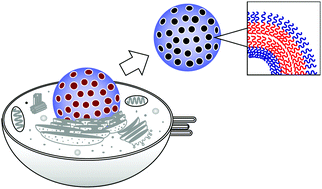Perforated vesicles composed of amphiphilic diblock copolymer: new artificial biomembrane model of nuclear envelope†
Abstract
With the aim of creating a new artificial model of a biomembrane for the nuclear envelope, perforated vesicles were prepared employing an amphiphilic diblock copolymer of poly(methacrylic acid)-block-poly(methyl methacrylate-random-methacrylic acid-random-2,2,6,6-tetramethyl-4-piperidyl methacrylate), PMAA-b-P(MMA-r-MAA-r-TPMA), by polymerization-induced self-assembly through photo nitroxide-mediated controlled/living radical polymerization (photo NMP). The photo NMP in an aqueous methanol solution produced spherical vesicles perforated with various holes and pores in the surface. The perforation of the vesicles was prevented by trifluoroacetic acid based on the disturbance of the MAA–TPMA interaction in the hydrophobic block chain. The investigation of the morphology changes by the polymerization progress revealed that the perforated spherical vesicles were produced within the membrane of contorted huge vesicles that were formed during the early stage of the polymerization due to the extension of the hydrophobic block chain. The perforated vesicles were found to show a reversible thermo-responsive behavior in the range of 25–50 °C based on dynamic light scattering and transmittance measurements. The vesicles were fused and divided into much smaller vesicles at high temperature, but were restored by cooling. However, the restored vesicles only had a few holes and no pores in the surface. The rearrangement of the MAA–TPMA interaction at high temperature produced more morphologically stable non-perforated vesicles.



 Please wait while we load your content...
Please wait while we load your content...